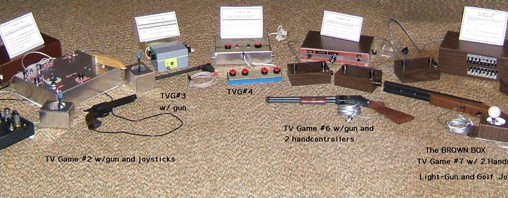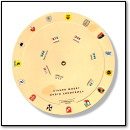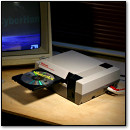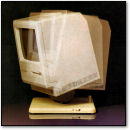[ VC&G Anthology ] Video Games Turn Forty (2007)
May 15th, 2017 by Benj EdwardsNote: this article was originally published on 1UP.com on May 15, 2007 under the title “Videogames Turn Forty.” (Original URL: http://www.1up.com/do/feature?pager.offset=0&cId=3159462).
Since 1UP is no longer with us, I decided to republish the article here for historical reference. I have learned quite a bit about video game history in the decade since this was originally published, and naturally some of my conclusions have changed. But this is still a great overview of the work done by Baer, Harrison, and Rusch in the 1960s. I plan to republish my other 1UP articles on VC&G as well in the near future. — Benj
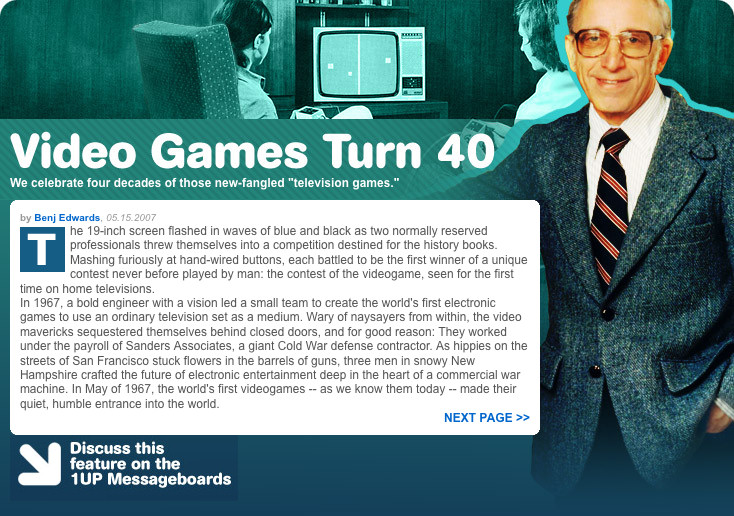
The nineteen-inch screen flashed in waves of blue and black as two normally reserved professionals threw themselves into a competition destined for the history books. Mashing furiously at hand wired buttons, each battled to be the first winner of a unique contest never before played by man: the contest of the video game.
 In 1967, a bold engineer with a vision led a small team to create the world’s first electronic games to use an ordinary television set as a medium. Wary of naysayers from within, the video mavericks sequestered themselves behind closed doors, and for good reason: they worked under the payroll of Sanders Associates, a giant Cold War defense contractor.
In 1967, a bold engineer with a vision led a small team to create the world’s first electronic games to use an ordinary television set as a medium. Wary of naysayers from within, the video mavericks sequestered themselves behind closed doors, and for good reason: they worked under the payroll of Sanders Associates, a giant Cold War defense contractor.
As hippies on the streets of San Francisco stuck flowers in the barrels of guns, three men in snowy New Hampshire crafted the future of electronic entertainment deep in the heart of a commercial war machine. In May of 1967, the world’s first video games — as we know them today — made their quiet, humble entrance into the world.
Epiphany, Take Two
Ralph Baer was already a seasoned engineer at Sanders Associates when he visited New York City on a business trip. Near the end of his stay, the 44 year-old Jewish immigrant and WWII veteran — whose family fled Nazi Germany on the eve of Kristallnacht in 1938 — found himself waiting at a bus terminal for an associate to arrive. As he rested on a concrete step, Baer basked in the warm late-August sun and set his mind adrift in a sea of thought.
It was there that Baer had his Eureka moment. The concept of playing games on an ordinary TV set bubbled up from the depths of his subconscious.
Amazingly, the idea for TV games had occurred to him briefly before, as early as 1951, while designing a television set for Loral Electronics. But in 1966 — at a different company and in a more influential position — it seemed that it might be the perfect time to develop the idea further.
Baer scribbled down notes as fast as they came to him. Those notes became the foundation of his first formal “TV games” patent disclosure document, dated September 1st, 1966. He wrote it out in exquisite detail when he returned to New Hampshire, making sure to fix his thoughts during that decisive moment in history firmly on paper.
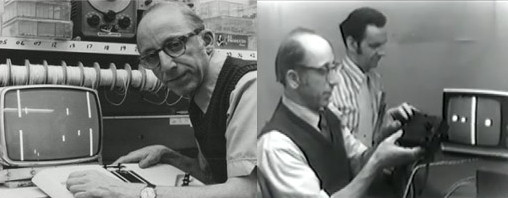
Right from the start, Baer dreamed of creating a consumer product for the mass market: “The idea was to make an alternative, interactive use of tens of millions of home TV sets then in homes world-wide,” wrote Baer in a recent email.
He envisioned his creation as an alternative to the general lack of selection available on the few broadcast channels of the day, imagining his games coming in on “Channel LP,” for “Let’s Play.” Later, he favored the more obvious and simpler term “TV games” to describe his novel and groundbreaking work.
Jewish Chutzpah
By early 1967, Ralph Baer had drafted William (“Bill”) Harrison, a bright and capable Sanders technician, into the new project as his chief hardware guru. Harrison had loyalty and respect for Baer’s knowledge and experience, and the two quickly found that they worked well together.
With the idea of TV games burning a hole in his pocket, Baer wasted no time in securing initial funding and support from certain visionaries in Sanders’ upper management, allowing him to put his vision into practice. Herbert Campman, Corporate Director of R&D at Sanders, was one of those visionaries. He served as Baer’s main advocate in the upper echelons of impeccably-suited, stern-faced executives at Sanders when it came to the utterly frivolous topic of video games. More importantly, Campman became the man immediately behind the purse strings of Baer’s pet project — and thus, the man to please.
The two engineers moved into a ten-foot by twelve-foot lab on the fifth floor of Sanders’ Canal Street building on Feb 12th, 1967. It was modest accommodations for an ambitious project. A long workbench stretched across a back wall, wired up for both electronic test equipment and their prized 19-inch RCA color TV set. A desk, a couple file cabinets, and two chairs filled the rest of the floor space. “It was a tight fit,” Baer recalls.
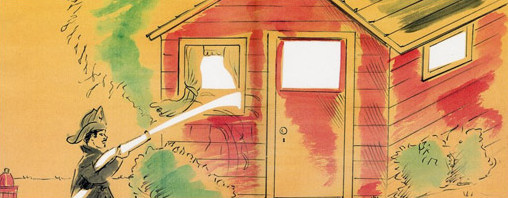
Baer kept the tiny lab, a former company library in Sanders’ early days, locked at all times. Only two men had keys: Baer and Harrison. The room would remain the base of operations for their controversial video experiments for years to come — experiments that, had they been known about widely at the time, might have garnered intense ridicule from other employees of the prominent defense contractor. Pursuing them was an utterly audacious move.
“To tell you the truth, it was a piece of Jewish chutzpah,” admitted Baer about his venture into the realm of amusements in the midst of a company accustomed to selling war.
At the time, Baer ran a five-hundred person engineering division with a multi-million dollar budget. He figured that putting a few technicians, like Harrison, on his pet project wouldn’t affect his departmental overhead — it would be a drop in the bucket for a huge company like Sanders. However, that simple drop would soon make a huge splash, then transform into an unstoppable, raging tsunami.
For now though, they were just beginning.
The First Game Developers
As their first order of business in the new lab, Baer and Harrison began work on a TV quiz game using a light pen as an input device. The player wielding the pen pointed it at one of several coded white spots on the screen, each corresponding to a different answer in a multiple choice quiz. If the player pointed the right answer, a green light on the pen device turned on. A wrong answer registered as a red light.
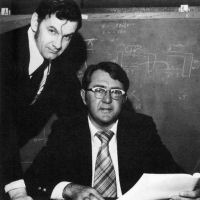 Baer and Harrison designed their light pen to work in conjunction with a specially prepared video tape that would effectively become “interactive” when combined with this technique. Promising as it was, work on the project soon screeched to an abrupt halt as Sanders management recalled Harrison to complete a pressing military project. TV games would have to wait. Meanwhile, life went on as usual at Sanders.
Baer and Harrison designed their light pen to work in conjunction with a specially prepared video tape that would effectively become “interactive” when combined with this technique. Promising as it was, work on the project soon screeched to an abrupt halt as Sanders management recalled Harrison to complete a pressing military project. TV games would have to wait. Meanwhile, life went on as usual at Sanders.
During the hiatus, Baer first met with William T. (“Bill”) Rusch, a brilliant and eccentric R&D engineer at Sanders. Rusch and Baer brainstormed on dozens of game ideas, all of which they documented in an amazing illustrated memo dated May 10th, 1967.
The landmark memo includes descriptions of Pole Position-style and overhead racing games, Combat-style chase games, maze games, roulette games, baseball games (among other sports), a Sabotage-style shooting game, golf putting, horse racing, and even more. Despite the long list, their best idea was yet to come.
On May 2nd, Bill Harrison returned to the fold, and work on the TV games project resumed. Baer and Rusch parted ways while Rusch continued work on another project.
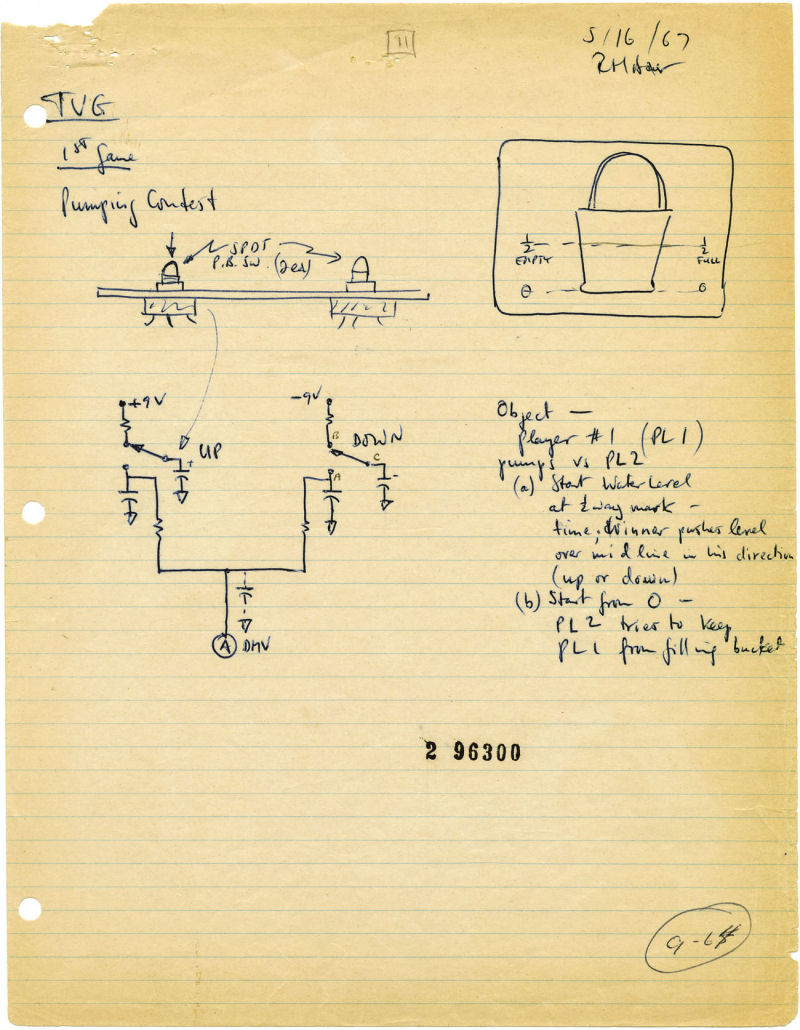 Over the next few weeks, Harrison built all the hardware necessary to split a TV screen horizontally into a black half on top, and blue half on bottom using a single “spot generator” circuit whose spot was stretched to fill as much of the screen as necessary. This became the basis of the first “pumping game” created by the pair.
Over the next few weeks, Harrison built all the hardware necessary to split a TV screen horizontally into a black half on top, and blue half on bottom using a single “spot generator” circuit whose spot was stretched to fill as much of the screen as necessary. This became the basis of the first “pumping game” created by the pair.
Baer whipped up an opaque overlay with a bucket-shaped cutout in the center and taped it over the screen of their modest TV. Known as the Bucket Filling Game, one player pushed a button rapidly, attempting to “pump” the blue water all the way up to the top of the bucket, while another player did the same, but controlling the top black half and attempting to pump all the water out.
“There was some heavy breathing going on while we whacked away at those dumb buttons,” wrote Baer in a book that detailed the events. “It was primitive, but it was a beginning, and it was fun, at least for a short time.”
After the game was over, Bill Harrison made an entry in his notebook dated May 15th, 1967:
“Circuits and control on previous page assembled and via a paper overlay on TV screen. The first contest was played between R.H. Baer and W. Harrison. Winner’s name will be withheld.“
Baer says that, in truth, the first ever two-player television video game contest in history was won by Harrison, who was kind enough not to boast about a victory over his boss.
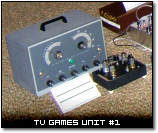 During the next few days, Harrison implemented four other games using the same basic circuitry and new overlays, including The Firefighters, Color Catching Contest, Roulette, and Car Ride.
During the next few days, Harrison implemented four other games using the same basic circuitry and new overlays, including The Firefighters, Color Catching Contest, Roulette, and Car Ride.
On May 22nd, Baer asked Harrison to add a second spot generator to the circuitry, and in such a way that the horizontal and vertical position of each spot could be controlled independently by two players. With that, the first “chase games” were born.
Each player had a joystick, with two spots on the screen. The first player, controlling one spot, avoided the second player, who tried to “catch” him by touching his spot to the first, thereby “wiping” it out.
Baer and Harrison continued to improve their games incrementally over time by adding new sections of circuitry here and there until the two men had constructed a complete, self-contained game device enclosed in an aluminum chassis that could be hooked to a normal television set to play games.
This unit, which they labeled “TVG Unit #2,” was the first video game console ever created. It was June 1967.
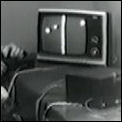 Joysticks. Who needs ’em? Modern Guitar Hero fans would feel right at home with Ralph Baer’s desire to create intuitive, natural interfaces for his video games in the 1960s.
Joysticks. Who needs ’em? Modern Guitar Hero fans would feel right at home with Ralph Baer’s desire to create intuitive, natural interfaces for his video games in the 1960s.
Most of Baer’s original TV game ideas involved input devices that mimicked their real world counterparts — steering wheels for racing games, roulette wheels for gambling on screen, and even an old-fashioned two-man water pump for a game about firefighters.
Baer and his technician, Bill Harrison, built some of his designs and used them frequently, like the “golf joystick” — a real golf ball attached to a joystick for putting games designed to be tapped with a real golf putter — and a pump handle for the “pumping” games that resembled the handle on a manual well pump.
Baer and Harrison really struck gold when they invented the world’s first television light guns — electronic toy rifles designed to be “fired” at targets on the screen.
Then there’s the whimsical: one of Baer’s game sketches from 1967 describes a game interface consisting of two straws that the player would blow through to fill a bucket with water on screen. Had Harrison built that device, a “bubble blowing” game probably wouldn’t have been far off.
Things never stood still for long in the lab at Sanders, as the engineers relentlessly added new functionality to their TV game devices, building off of the old ones.
Some of the first improvements included a game with a random spot generation circuit called Fox and Hounds. The duo also implemented the first on-screen scoring display around this period, which consisted of a vertical bar on one side of the screen that would raise or lower behind the graduated cutout of an overlay. The taller the bar, the higher the score.
Baer and Harrison completed another important innovation by early June: the world’s first television “light gun,” constructed by Harrison for target shooting games when aimed and “fired” at a television screen. The first gun unit was a crude affair, but by the second model, Harrison had mounted the necessary electronics in a toy rifle he purchased at a nearby Sears department store.
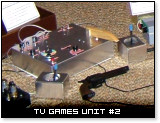 The light gun, as an input device, was a natural extension of the TV quiz light pen that the pair developed back in February. Harrison simply moved the optics to the back of a long barrel, added a lens, and suddenly players could stand six feet away from the screen and “shoot” target spots produced by TVG Unit #2, either controlled by a second player or generated randomly.
The light gun, as an input device, was a natural extension of the TV quiz light pen that the pair developed back in February. Harrison simply moved the optics to the back of a long barrel, added a lens, and suddenly players could stand six feet away from the screen and “shoot” target spots produced by TVG Unit #2, either controlled by a second player or generated randomly.
Despite the pair’s attempts at secrecy, word quickly spread around the company that Baer was “screwing around” with some sort of newfangled TV gadgetry. The duo couldn’t keep the project under wraps any longer. It was time to show their work to executive management at Sanders.
In attendance at this make-or-break demo was the company’s president, Royden Sanders, the Executive Vice-President, and the entire Board of Directors. Baer presented seven different color video games in a company conference room, each game accompanied by voice-over instructions from audio cassette that were played through the TV speaker.
The demo went off flawlessly. Some of the attendees walked away impressed, while others still thought it was a waste of time. They had trouble seeing how anything commercially worthwhile could come out of it.
Ultimately, the demonstration was a success because the President decided the give the go-ahead on additional game development, with the caveat that the main focus of the research shift to exploring commercial applications of the new TV game technology.
Crafting a Product
In August, Baer and Harrison completed TVG Unit #3, a self-contained 5x5x6-inch box that excluded unnecessary and costly circuitry from the last game unit. The stripped-down unit focused on “chase” and “gun” games only, excluding features like color and the “pumping” hardware.
Baer next put Harrison on the task of reducing the cost of the unit even more so it could be mass produced. Harrison used every ounce of ingenuity to reduce the part count as much as possible, a feat of genius that Baer appreciates to this day.
Still, after running bill of materials calculations on their best effort, the two realized that there was not enough play value in the games they had created to offset the projected cost. Baer originally wanted his box to sell for $25 retail, but reality stepped in.
“It was clear that we needed to do something different, something more exciting that would warrant a probable $50.00 retail price for a TV game,” recalls Baer.
Around this time, the duo also explored re-implementing their games using digital TTL logic chips, like those used in the first arcade video games five years later, but the cost of the chips in 1967 made them impractical for a low cost consumer product.
Baer and Harrison wracked their brains for new game ideas to improve their unit’s perceived value. Chase games and gun games were already getting old. Under the recommendation of Herb Campman, Bill Rusch joined the team on August 18th to breathe new life into the project.
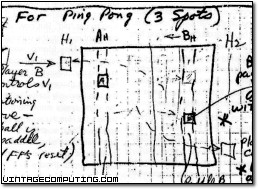 Rusch, like a creative spigot, could pour out new ideas on command, making him invaluable to R&D. The duo was now a trio, and the stage was set for a breakthrough. Rusch started off slow by restoring color to TVG Unit #3 and improving the unit’s R.F. modulator design over the next few months. All the while, he laid down page after page of new game designs on paper.
Rusch, like a creative spigot, could pour out new ideas on command, making him invaluable to R&D. The duo was now a trio, and the stage was set for a breakthrough. Rusch started off slow by restoring color to TVG Unit #3 and improving the unit’s R.F. modulator design over the next few months. All the while, he laid down page after page of new game designs on paper.
In October, Rusch hit upon a brilliant idea: he added a third, machine-controlled spot to the games. This simple addition proved to be a pivotal contribution to the development of video games, one for which he later received an important patent.
Rusch then took this idea one step further and treated the third spot as a “ball” that could be used in games like soccer, hockey, and ping pong. The first two player-controlled spots would then function as “paddles” that could manipulate the movement of the ball.
Ping-Pong was born — a game that would later start a national craze in the form of Atari’s Pong. Rusch scribbled down the design of Ping-Pong, complete with illustrations of the game field and play mechanics, on October 18th, 1967.
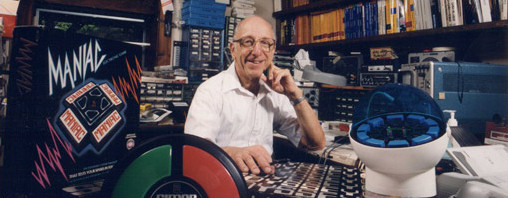
Harrison quickly implemented Rusch’s “third spot” ideas into hardware. By early November ’67, Harrison presented a working Ping-Pong prototype, along with chase and gun games, in a new chassis named “TVG Unit #4.” Herb Campman soon demoed the new unit and gave it an enthusiastic thumbs up.
Baer’s project received more R&D money as the trio continued to improve the design of their hardware, eventually adding the first tennis, hockey, handball, and soccer video games to their list of achievements.
Late in the year, an uncomfortable tension grew between Baer and Rusch over differences in circuit design. A confrontation between the two extremely confident and strong-willed men was nearly a given from the start, as each constantly vied for the supremacy of their ideas. But only one man could be the boss.
According to Baer, Rusch became unmanageable and drifted away from the team, often coming into the office later and spending hours on the phone with a stock broker.
Despite his erratic behavior, Rusch continued develop game designs in his journal. One of his most ingenious creations involved a complex analog circuit to simulate the velocity and direction of a ball when hit by a paddle in a certain way. [Atari’s Pong later implemented this improvement, which was an important distinction between the two ping-pong games — Ed., 2017] Despite its brilliance, Baer decided to put off work on the circuit until later.
The team could have kept adding on features forever, but at some point they had to draw the line and move towards turning their work into a real product. As 1967 drew to a close, the trio looked back at an enormously productive year of incredible innovation and relentless achievement.
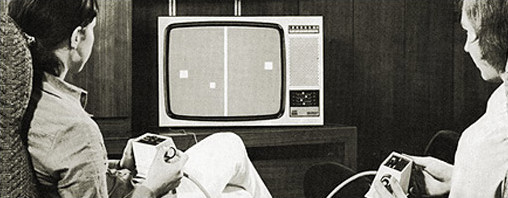
Onward and Upward
Baer, Harrison, and Rusch worked on TV games for the remainder of the decade, culminating in the license of their technology to Magnavox, a major TV manufacturer at the time.
Magnavox used the license to develop the world’s first home video game system, the Odyssey, which was almost an exact copy of a 1968-69 Sanders prototype known as the “Brown Box.” Launched in 1972, the overpriced and mismanaged Odyssey package was a modest commercial success, but being based on mid-1960s technology, it was effectively outdated by the time it was released.
While introducing the concept of the home video game console and ultimately starting the video game revolution, the Odyssey failed to excite the popular imagination. That task would be left to a young entrepreneur named Nolan Bushnell and his company Atari, whose second game, Pong, proved to be the essential catalyst needed to kick-start the video game industry.
It’s no coincidence that Pong looks a little familiar to the Ping-Pong game created by Baer’s team at Sanders: Bushnell based his game directly on a demonstration of the Odyssey that he witnessed on May 24th, 1972 at a dealer and press exposition of the new console in California.
With the help of various engineers and technicians, Baer continued to create innovative new video-related technologies throughout the 1970s and beyond, each worthy of its own chapter in history.
By the late ’70s, Baer’s once maligned video game technology at Sanders had become the company’s shining star. Licensing agreements from the Baer, Harrison, and Rusch video game patents were a huge cash cow for the company, then struggling from tough times in the defense industry.
“We’d be in the quarterly meeting, along with other division managers, looking at the performance of various divisions,” recalls Baer, “and our licensing income was always bigger than that of the biggest division of the company.”
At that point, Baer was nigh but untouchable by upper management. He escaped the stressful task of heading a huge division and settled into a flexible R&D position that offered him ample creative freedom. Meanwhile, he began doing his own independent toy and game design on the side — intellectually satisfying work at which he has found continued success over the last three decades.
 In 1976, Magnavox began its pursuit of Sanders video game patent infringers. The main licensing agreement between Sanders and Magnavox put the burden of protecting Sanders’ video game patents squarely on Magnavox.
In 1976, Magnavox began its pursuit of Sanders video game patent infringers. The main licensing agreement between Sanders and Magnavox put the burden of protecting Sanders’ video game patents squarely on Magnavox.
After a slow start, Magnavox soon began suing nearly every video game company in the industry, forcing them to become licensees of the Sanders/Magnavox technology. All the while, Magnavox did little to innovate video game technology themselves, even so far as rejecting all of Ralph Baer’s advice for upgrades and enhancements to the Odyssey line.
Ultimately, Magnavox drafted Ralph Baer into their legal efforts. As a loyal employee of Sanders, he saw it in his best interest to help secure licensing revenue for his company. Baer testified as a witness in dozens of patent trials over the course of two decades, all of which were won by Magnavox.
Due to his participation in these lawsuits, certain critics of Baer like to characterize him as long in litigation and short in innovation. That couldn’t be further from the truth. “I didn’t sue anybody,” says Baer in his book, “It was Magnavox who went after infringers on behalf of themselves and Sanders Associates, to whom my patents and those of Bill Rusch and Bill Harrison had been assigned.”
In fact, if he wanted to keep his job, he had little choice but to cooperate. Meanwhile, Ralph spent most of his time not in the courtroom, but in the lab at Sanders, inventing as usual.
Legacy
In the 1960s, Ralph Baer was adamant in requiring his engineers to keep copious, detailed notes documenting all their work on the TV games project. His meticulous nature paid off: we now have verifiable journal entries, diagrams, and electronic schematics that not only confirm Baer’s story, but allow a rare window into the minds of the three men at the time they were creating the world’s first television games.
Historians can rest easy knowing that some of the nation’s most prestigious professional archivists recently recognized the historical importance of the Sanders work and took charge of preserving the team’s legacy for future generations.
With the invaluable assistance of Ralph Baer, who rescued all the documents and prototypes he could find, the original TV game-related hardware, journals, and paperwork that remain are now preserved in the Lemelson Center at the Smithsonian Institute in Washington, DC. Baer has also built fully functioning replicas of all the original TV games units for placement in museums all around the world.
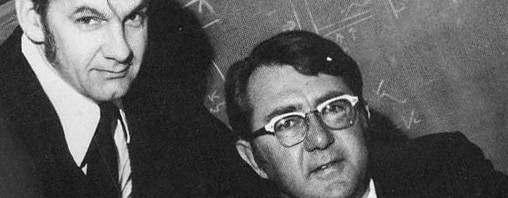
Despite having racked up enough landmark achievements for several lifetimes, Baer shows no signs of quitting. Now 85 years old, he continues to develop electronic toys and games from his workshop at home. The modern world of video games, at its light-speed pace, has long since passed him by, but he’ll always remain incredibly proud of the contributions he made at the very beginning.
Bill Harrison left Sanders Associates in 1978 for a new life in sunny Florida. There, he worked 19 years as VP of Engineering for International Laser Systems. Now 73 and retired, he spends time fixing up old cars and sailing when he gets the chance.
Harrison says the thing he’ll always remember most about the TV games project was the great people he worked with. “It was a fun job to work on, and especially working with Ralph,” said Harrison as he reflected in a recent interview. “Boy, those were good years.” He and Baer are close friends to this day.
As the square peg of the trio, we tend to hear about Bill Rusch the least from Baer’s accounts of TV game history. Rusch’s oldest son, Jim Rusch, says that his father retired from Sanders (then known as Lockheed-Sanders) around 1990. The elder Rusch, a multi-talented musician, athlete, artist, and engineer, created many innovative works in his lifetime, but he considered Ping-Pong one of his greatest achievements.
A few years after retiring, Bill Rusch went to see his doctor, complaining of acute back pain. The doctor discovered cancer that had already spread throughout his body. He died six weeks later, in July of 1993, at the age of 63.
The First Video Games Ever?
Historians have documented a number of potential candidates for the title of “first video game,” including three that predate 1967. But the games created that year held one major distinction from all the rest, a distinction whose importance was upheld by dozens of legal trials through the decades, and one considered paramount by historians: they were designed to be played on an ordinary home TV set by ordinary people.
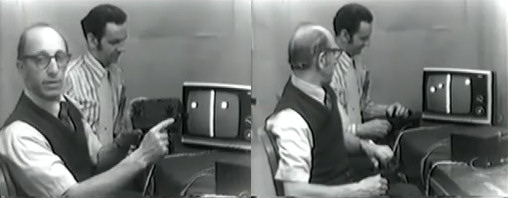
“That’s the seminal idea,” said Ralph Baer in an interview conducted last January. And although it seems obvious to us now, before Ralph Baer came along, no one had developed electronic hardware for the purpose of playing games using an unmodified consumer television set.
The precise term “video game” was not coined by Ralph Baer; it came along later in reference to electronic video arcade games of the early 1970s. But one could argue that Baer’s innovative electronic TV games were the first video games ever created.
One narrow way of looking at the issue of the first video game is that the other possible firsts most commonly cited — William Higinbotham’s “Tennis for Two” (1958), Steve Russell’s Spacewar (1962), and even Thomas R. Goldsmith Jr.’s undeveloped 1948 missile game patent — did not use video displays; they used vector displays.
So what’s the difference? Most dictionaries provide a vague and often recursive definition of “video” that nonetheless always mentions television, and numerous historical news accounts from the 1950s to the 1980s treat “television” and “video” as nearly synonymous. The technology of television involves creating the illusion of motion through the rapid succession of individual still images.
Vector displays were neither designed nor used (typically) to show a sequence of still images in motion, nor were they ever used in television sets, and by this strict definition, they are not video displays.
The three games mentioned above, all unknown to Baer and his team at the time of his invention, utilized an electronic vector display similar to an oscilloscope for their graphical output (Spacewar’s display, while not an oscilloscope, was technologically similar). While the display tubes in oscilloscopes are indeed cathode-ray tubes (CRTs) that are similar in many ways to television picture tubes, the means by which images are actually drawn on the two are entirely different.
 Traditional vector cathode-ray tubes usually have one electron gun that is guided explicitly to x,y coordinate spots on the screen’s display area. The gun emits a stream of electrons at the screen towards the phosphor-coated screen surface.
Traditional vector cathode-ray tubes usually have one electron gun that is guided explicitly to x,y coordinate spots on the screen’s display area. The gun emits a stream of electrons at the screen towards the phosphor-coated screen surface.
When the electrons hit the screen, the phosphors are energized, producing visible light. Viewers on the outside of the tube (a good place to be while all this is happening) see this as a glowing spot on the face of the tube.
If the gun is moved across the screen while it’s emitting electrons, viewers see that as a glowing line. In this way, shapes, curves, and points can easily be traced out on a vector display via specific instructions from whatever is controlling it.
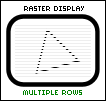 Raster displays, like those used in picture-tube television sets, typically have one or three electron guns, depending on whether it is a black and white or color display.
Raster displays, like those used in picture-tube television sets, typically have one or three electron guns, depending on whether it is a black and white or color display.
In a typical interlaced raster video signal, the guns sweep out one full line of an image at a time horizontally, proceeding down the screen until half of an image (known as a “field”) is displayed. The guns repeat this for the other half of the lines, completing a full frame. While doing this, the electron streams are varied in intensity according to how light or dark a certain area of the image is. The guns sweep out thirty frames every second, producing the illusion of motion.
Because of the ease at which a vector display’s electron gun can be guided to any point on the screen of an oscilloscope, making a game using vector technology was far more obvious than making one that used a raster display. Generating graphics on a raster display, like a television set, was no cup of tea.
“There was nothing trivial about inventing a way for ordinary people to interact with their TV sets, no matter how primitive the game was,” says Baer.
Even without delving into the technical back-end of things, it’s obvious that the “video” definition argument, when taken alone, rings a little hollow and oversimplifies the issue into one of mere semantics. Yes, there’s an electronic difference between raster and vector displays, but regardless of the exact type used, the end result remains the same.
After all, Atari introduced vector display arcade games like Asteroids and Tempest in the 1970s and ’80s that are commonly considered video games, and no one argues with that. So what’s the real key to the puzzle?
It all comes down to lineage. Baer’s technology begat the video games that the vast majority of video game enthusiasts play now: games using home video displays as a medium.
The video games you see and play today are direct linear descendants of his invention. After all, how often does one see companies selling games designed for play on the family oscilloscope?
Steve Wozniak, co-founder of Apple Computer, is a well-known cheerleader of Baer’s work. “I worked as hard as I could to get him every award he deserves,” said Wozniak in a recent interview — about awards that include the National Medal of Technology, presented to Baer in 2005 by the President of the United States for his pioneering work with video games.
When asked why he thinks Baer should be considered the inventor of video games, Woz was quick with praise. “He made the first ones, long before even Atari. And he did it so early, one after another, after another.”
 It’s inevitable that a comparison between Bill Rusch’s Ping-Pong and William Higinbotham’s electronic Tennis game is often made.
It’s inevitable that a comparison between Bill Rusch’s Ping-Pong and William Higinbotham’s electronic Tennis game is often made.
“Tennis for Two,” as it is often called, was an oscilloscope game utilizing analog computers that was first constructed by Higinbotham in 1958 as an amusement for visitors to Brookhaven National Laboratory, where Higinbotham worked. Displayed only twice, and to a limited audience, Higinbotham’s creation remained largely unknown to the public until a 1982 article in Creative Computing magazine.
Tennis for Two’s reputation further got a boost in the 1980s when Higinbotham was unearthed as a witness by Nintendo in a counter-lawsuit against Magnavox whose aim was to nullify the Sanders/Magnavox video game patents. That was the first time Baer or his team had heard of Higinbotham and his game.
Some see a connection in the use of Tennis as metaphor for both of games, but that’s where the similarity ends. The gameplay of the two games is entirely different.
One of the vital differences is that Tennis for Two portrays a “side” rather than an overhead view of a tennis court. Tennis for Two even lacked representations of the two players on screen (spots typically known as “paddles” in Rusch’s game), which in some ways made Higinbotham’s game resemble a ballistic trajectory simulation more than a friendly game of tennis.
But don’t earlier games like Spacewar! diminish Baer’s achievement?
“No, no,” insisted Wozniak. “If you have a million dollars to spend on some research group and equipment in a university, you could have the equipment there to make a game so far ahead of where it could really be sold to the world. The talent is really making something at a price people could afford. That’s what Ralph did. Anyone with infinite amounts of money can do projects that would be impossible to do at affordable cost today.”
Wozniak brings up a great point. Like Apple’s innovations with the personal computer — a machine designed to be affordable, accessible, and usable by anyone — Baer essentially created the “personal video game.” All electronic CRT games previous to Baer’s were technological curiosities; non-commercial dead-ends with immense requirements for operation that, as a result, remained in the hands of the elite and the few instead of spreading to the masses.
It’s true that the elaborate and ambitious Spacewar!, which required a $120,000 DEC PDP-1 computer to function, was the inspiration for a milestone commercial product by Nolan Bushnell and Ted Dabney in the form of Computer Space (1971), the world’s first coin-operated video game. But alas, it was the more plebeian Pong, a tweaked and improved clone of Bill Rusch’s down-to-earth Ping-Pong game, that launched the video game industry into the mainstream.
Even Atari’s wildly successful home Pong unit (1975), a product that started the headlong commercial rush into the home console market, could not help but borrow pages (and patents) from the Sanders-invented Magnavox Odyssey that preceded it.
As Baer himself once said, “It is physically and logically impossible to be the father of anything unless there is a child.” By any standard, Baer’s creation definitely bore fruit — fruit that we see all around us today.
So whether they go by “TV games” or the infinitely more bland euphemism “interactive entertainment,” Ralph Baer is truly the father of video games, regardless of what they are called, making Bill Harrison their mother, and Bill Rusch the estranged uncle.
Welcome back to the family, Rusch. And happy 40th anniversary.
